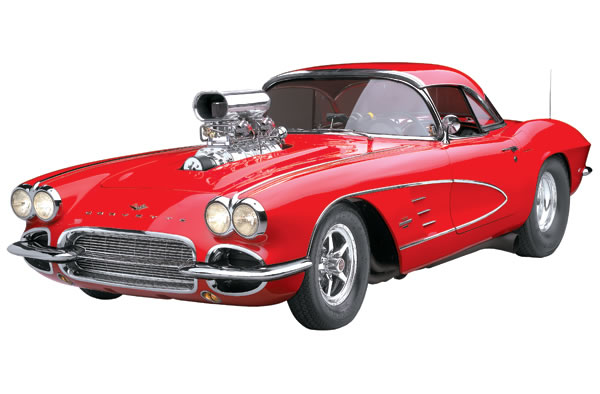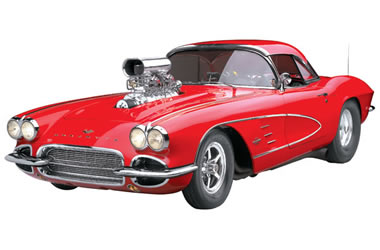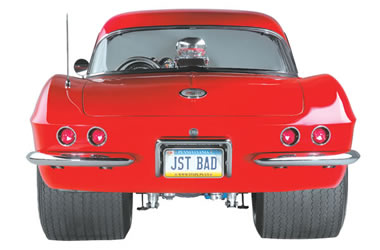Art and Mary Krepps’ 1961 Corvette
Art Krepps built his 1961 Corvette with one hand tied behind his back. Well, maybe we’re exaggerating just a bit. But he did bring the ’Vette from backyard trash to a showstopper himself, with help from his sons. That includes fabrication, body work, paint, engine work, interior, and anything else custom the car needed.
It just goes to show you that if you want something done right, you gotta do it yourself. From the big-as-life BDS 8-71 supercharger sticking up out of the hood to the stock-appearing body and interior and five-inch exhaust tips that peek out in front of the rear tires, the Vette is an all-around awesome car.
“Most people have a list of shops that did the body work, paint, and fabrication,” Art said. “Doing that work myself was the most rewarding part of the project. I put a lot of hard work into making it just the way I wanted it. I had a good idea of the engine this car would have so I built everything as strong as possible. And except for being tubbed and having a blower sticking out of the hood, it still looks original.”
The Corvette started out like so many cars—as an “empty nest” project. After Art and his wife Mary raised their two sons, the high performance bug came back with a vengeance. Art was preparing a motor and transmission for a 1974 Corvette, but both he and Mary were quite fond of the 1961 body style. He found just what he was looking for: a raggedy ’61 that needed some attention in a bad way.
Not that there weren’t accomodations that needed to be made for the car.
“He kicked me out of my spot in the garage, but that didn’t last long,” Mary said. “Soon he built a bay-and-a-half addition just for the project. He had plenty of room and I got my parking spot back.”
Wise move there, Art.
A concrete contractor by trade (A.C. Krepps & Son Concrete Contracting), Art happens to have a lot of free time during the cold winter months in Pennsylvania. In the three years he spent working on the car, Art backhalved the frame, replaced the front end, fabricated the trunk, and radiator mounts, and cut an access hole in the hood that perfectly follows the supercharger’s lines.
When you peek under that hood, a L88 427 with a pair of Larson two-piece valve covers will stare back at you.
“I get a lot of people who think [the valve covers] are the cylinder heads because they’re so big,” Art said. “People have offered to buy them, but I’m not giving ’em up—I’ve only seen one other set.”
The supercharged L88 puts out an estimated 850 horsepower at 6,000 rpm. Art needed an exhaust system that wouldn’t rob any power, so he he fabbed a system from a pair of four-inch diesel truck mufflers, Car Chemistry inserts, and five-inch exhaust outlets. The no-nonsense, stovepipe black finish keeps the big pipes from looking too obvious and detracting from the Corvette’s body lines.
In his mission to keep the car as close to stock as possible, Art didn’t cut up the dashboard to fit the Auto Meter Pro-Comp gauges. He made a custom console that simply slips over the original center console and holds the gauges in an easy-to-read spot. He also recovered the seats so they’re look like newer, cleaner versions of the factory originals.
Between the local car shows and cruising with one of the two clubs they belong to (The Cruizin Few and Corvettes of PA), Art and Mary put about 500 miles on the Corvette every year.
And when the neighbor’s windows start to rattle, everybody knows the Krepps are home.
FAST SPECS
Chassis
Frame: Stock frame with 2-inch x 3-inch tube backhalf, extended front frame rails, custom body and radiator mounts
Rear Axle: Ford 9-inch wiith Strange 31-spline axles, 4.33 ratio Richmond Gear ring and pinion, Detroit Locker differential
Rear Suspension: Chassis Engineering adjustable ladder bars, Aldan adjustable coil-over shocks, Competition Engineering diagonal link
Front Suspension: Fat Man Fabrication Mustang II tubular A arms, Heidt’s 2-inch dropped spindles, power rack and pinion steering
Brakes: 11-inch Wilwood front disc brakes, 11-inch GM rear disc brakes
Wheels and Tires: Weld Aluma-Star wheels (3 1/2 x 15 front, 15 x 15 rear), Mickey Thompson Sportsman tires (28 x 7.50 front, 33 x 21.5-15 rear)
Other Items: Street & Performance polished aluminum steering pump, urethane mounts and bushings, custom driveshaft
Chassis Work: Art Krepps
Engine and Transmission
Engine Type: 1969 Chevy L88 427
Block: Cast iron, bored .030 inch over
Reciprocating Assembly: GM steel crank, GM “pink” rods, 8:1 TRW forged pistons—assembly balanced and blueprinted
Camshaft: GM solid lifter cam, .600-inch lift
Cylinder Heads: GM aluminum L88
Valvetrain: GM 7/16-inch pushrods, 1.7 ratio Harland Sharp roller rocker arms
Induction: Edelbrock intake manifold, two 750 cfm Holley double pumper carburetors, BDS 8-71 Stage II supercharger (approximately 14 psi), Hilborn style scoop with K&N air filters
Ignition: Taylor Vertex magneto, Auto Meter Pro-Control, Taylor ignition wires
Cooling: Two 13″ Be Cool electric fans, custom-built Be Cool radiator, custom aluminum radiator hose, Aeroquip braided lines, Edelbrock aluminum water pump
Exhaust: Hedman fenderwell headers with 2 1/8-inch primaries, 4-inch diesel truck mufflers, 3-disc Car Chemistry inserts, 5-inch exhaust outlets
Transmission: Turbo 400 transmission by Carl Rossler, 10-inch/3,500 rpm stall converter, Hughes transmission and flexplate shields
Other Items: Tilton Super Starter, Optima battery, Summit aluminum pulleys, Mallory 140 Comp fuel pump, Pete Jackson gear drive, Hurst Line Lock, ATI flexplate
Body
Modifications: Modified hood for blower clearance, custom hinges to allow hood to come up and forward
Paint Color: PPG Bright and Bold Cherry Red
Fabrication and Paint By: Art Krepps
Interior
Upholstery: Black vinyl
Seats: Original, recovered with new foam
Dash: Stock
Gauges: Auto Meter Pro-Comp gauges, Auto Meter 5-inch memory recall tach with Pro Shift Lite
Shifter: B&M Hammer shifter
Other Items: Custom-built center console and gauge panel, Simpson 5-point harnesses
Special Thanks To:
My wife Mary, for all of her love, patience, and understanding; sons Jason and Josh, for always being there even into the wee hours of the morning; John Chevalier, owner of J & S Auto Body, for use of his paint booth; good friends Ed, John, and Barry for their expert input and support










Niccccccccce! & Awesome!
Big Block Chevy 427 800Hp Oah Yah Mannnnn I Miss My 510HP 454.